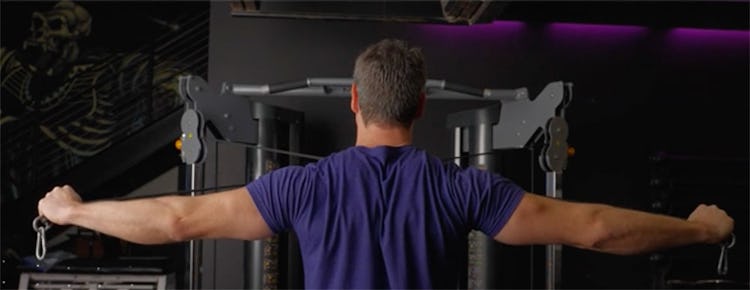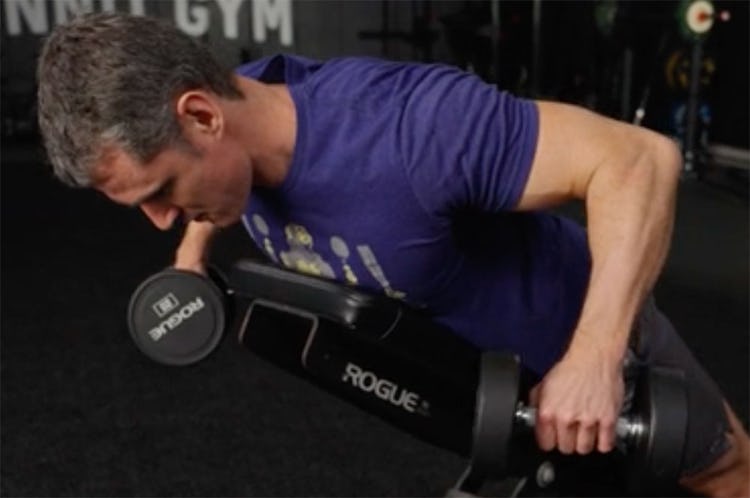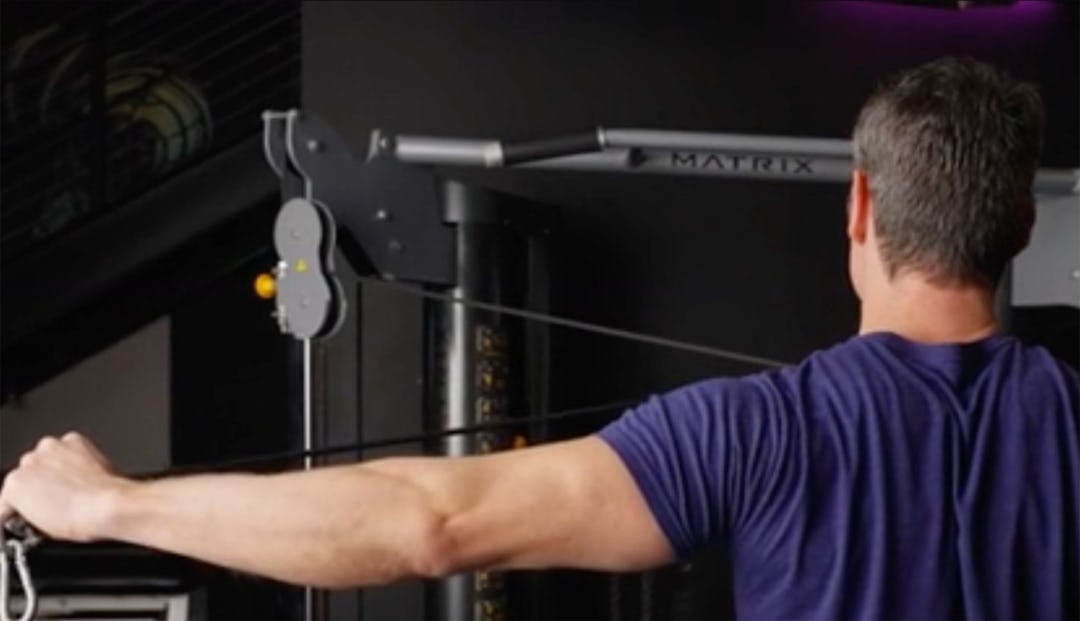The rear-delt fly exercise can be performed with cables or dumbbells, and either version is a solid choice for isolating the posterior head of the shoulder muscle. But our Editor-in-Chief, Sean Hyson, CSCS, breaks down which of the two is the best choice and how to do it for the best gains.
What Is The Rear-Delt Fly and What Are Its Benefits?
(See 00:29 in the video above.)
The rear-delt fly is the simplest and most direct way to train the rear deltoid—the little muscle on the back of your shoulder. You start with your arm in front of your body and you extend it out to your side.
Rear-delt flys are important because most people have lopsided shoulders. They sit staring at a computer or their phone all day, rounding their upper back, and that causes the posterior muscles to weaken and lengthen while the anterior muscles get tighter. If you’re a fitness fiend, you probably do too much pressing and chest work in relation to your rowing and rear-delt work, and that contributes to the imbalance. So rear-delt flys help to build up the back of the shoulder, which contributes to the appearance of bigger and more even shoulders overall. Rear-delt flys can help to prevent shoulder injury by restoring muscle balance, as strong rear delts help keep the shoulder joints centered, rather than pulled forward, which wards off shoulder injuries like an impingement.
How To Do The Rear-Delt Cable Fly Correctly
(See 01:23 in the video.)

There are several ways to do a rear-delt fly with cables, but the version that follows is the most straight-forward.
Step 1. Set both pulleys at an adjustable dual cable station to the height of your head. Grasp the cables themselves with your palms facing down, crossing one arm over the other, and stand with your feet between hip and shoulder-width apart. You may want to stagger your stance for extra balance. Step back a bit so you feel tension on the cables and a light stretch in your rear delts before you even begin the set.
Step 2. Brace your core. Now drive your arms straight out to your sides while keeping a slight bend in your elbows. You really have to do this as an arcing motion, as if reaching out for the walls around you. Stop when your arms are 90 degrees.
Step 3. Lower the cables under control, and stop just short of where the weights touch down on the stack. You want to keep your rear delts working throughout the entire set, and letting the weight rest for a moment lets your delts rest too.
You can also do the fly using single-grip or D handles attached to the cables and your palms facing each other. This may bring a little more of your lateral delts into the exercise, but that isn’t a terrible thing. Ultimately, choose the setup and hand position that feels most comfortable to you and allows you to train the exercise hard and heavy.
How To Do The Dumbbell Rear-Delt Fly Correctly
(See 02:37 in the video.)
Without the tension of cables, you’ll have to adjust your body position to allow your rear delts to work against gravity. This can be done easily by bending at the hips so your torso faces the floor. Now when you perform the fly motion, your arms will be lifting up from vertical to 90 degrees to the floor, shortening the rear delt muscle completely.
Step 1. Hold a dumbbell in each hand and bend your hips back until your chest faces the floor. Keep a long spine as you do so to protect your lower back. Turn your hands so your palms face your legs.
Step 2. Raise the dumbbells out to your sides 90 degrees while keeping a slight bend in the elbows. Your torso should remain motionless.
Step 3. Control the descent and stop a little short of your arms being vertical. Again, you want to keep tension on the delts.
Note that this same motion can be done with cables as well, if you only have access to a station that has low pulleys, or won’t adjust to shoulder level.
If you have an adjustable bench, it’s a good idea to do the rear delt fly—with both cables or dumbbells—using the bench for support. The bench stabilizes your body for you, and that will allow you to focus more on the rear delts and give them a better stimulus. It will also force you to do the movement more strictly, as many people have a tendency to bounce their torso when doing dumbbell rear-delt flys.
What Muscles Do Rear-Delt Flys Work?
(See 03:31 in the video.)
No big surprises here. The rear-delt fly works—ta dah!—the rear deltoids. Your upper back muscles, such as the trapezius and rhomboids, will also get involved a little bit, but that’s why it’s so important to raise your arms out only to 90 degrees, where they’re in line with your sides. While it might seem like extending your arm back further will give you an even better contraction in the deltoid, you’re really just bringing the traps into the movement even more. The rear-delt fly is supposed to isolate the deltoids so you can focus on building up that muscle alone, so do it right and let the target muscles do their thing.
Is One Variation Better Than The Other? Who Should Do Which?
(See 04:05 in the video.)
OK, so here’s the big question: should you do the rear-delt fly with cables or dumbbells? Well, the advantage of a cable is that the resistance is constant throughout the whole range of motion. That means that even when your arms are in front of you, your deltoids are still going to be working pretty hard. You’ll notice that when you use dumbbells, this isn’t the case—the tension drops off the delts completely when your arms point toward the floor, and the fly feels the hardest at the end of the range of motion when your arms are extended at your side.
Either version is OK, and if you train at home or only have access to dumbbells, then the dumbbell rear-delt fly is what you’ll have to rely on to build your rear delt muscles. But if you can get your hands on a cable, it’s the better choice for a more complete rear-delt workout. Another good alternative would be exercise bands, which keep tension on the delts throughout the whole range.
How To Stretch Before Doing Rear-Delt Flys
Follow these five steps to better shoulder mobility—courtesy of Dr. Layne Palm (@laynepalmdc)—to warm up and stretch your shoulders before taking on any rear-delt workout.
Other Rear Delt Fly Variations
Rear-Delt Cable X Fly
(See 05:00 in the Rear-Delt Cable Fly video above.)
The rear-delt fly doesn’t always have to be done with your arms traveling to 90 degrees. Some trainers argue that if you perform the fly with a 45-degree arm path, you’ll be able to go a little further into shoulder extension and contract the rear delts even harder without getting the upper back involved. This point is debatable, but the rear-delt cable X fly is a worthy variation to experiment with.
Step 1. Set the pulleys of a cable station up high, at least to shoulder level. Grasp the cables themselves—you don’t need a handle—with a crossover grip, and step back so you feel some tension on the cables. Stagger your stance for balance.
Step 2. Extend your arms in a 45-degree path, as if drawing an X in the air, until your rear delts are fully shortened. (Your arms will be behind your body.) Keep your arms fairly straight, and don’t extend your elbows as you fly—that would turn the movement into more of a triceps exercise.
Rear-Delt Row
(See 05:45 in the Rear-Delt Cable Fly video.)

While a fly motion lets you work your rear delts without assistance from the back and biceps, it’s not the only way to train the rear delts. Rowing exercises certainly hit the rear delts as well, and you can emphasize them over the back muscles with a rear-delt row variation.
Step 1. Set an adjustable bench to a 45-degree incline and lie down with your chest against the pad. Grasp a dumbbell in each hand.
Step 2. Row the weights up with your elbows pointing 45 degrees out from your sides. Row until your upper back and rear delts are fully contracted, and then lower under control.
FYI, any row variation where the elbows are flared (as opposed to tucked near your sides) will recruit the rear delts significantly.
How To Fit The Rear-Delt Fly Into Your Workout
(See 06:45 in the Rear-Delt Cable Fly video.)
Rear-delt exercises in general are often left to the end of upper-body workouts, but if your rear delts are lagging, it’s a good idea to do them first in your session when you’re fresh and can give them your best effort. A few sets of rear-delt cable flys before you do any pressing or lateral deltoid work will help to bring your rear delts up fast.
In general, 2–3 sets of 5–10 reps is enough rear-delt training for any one workout. Do it twice a week with two different exercises. For example, one session could feature the rear-delt cable fly and the other the dumbbell rear-delt fly, or the cable X fly.

)





